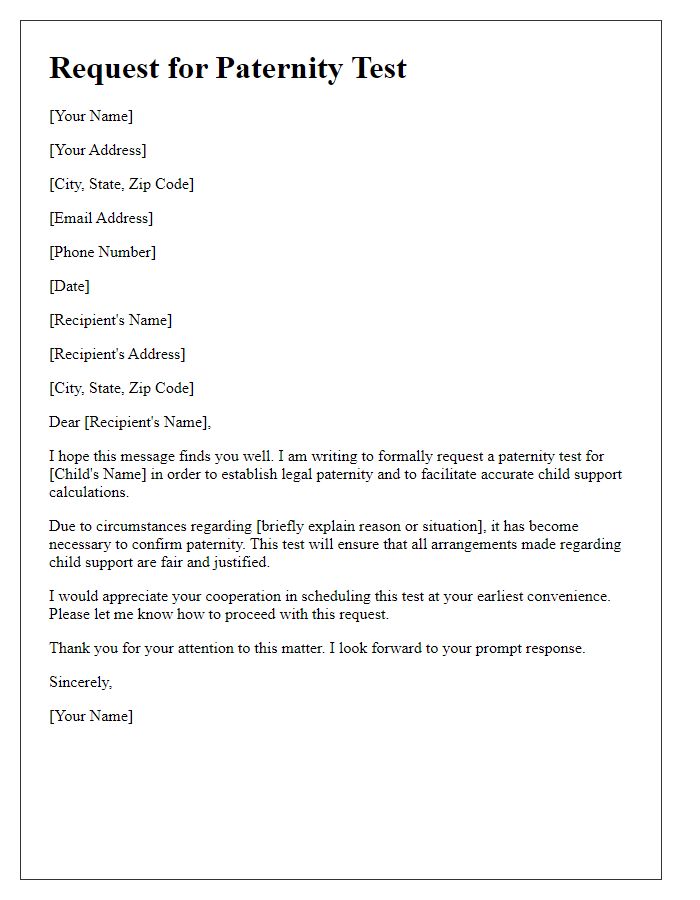Are you looking for a way to navigate the sensitive topic of requesting a paternity test? Writing a letter can be an effective and respectful approach to communicate your intentions. It allows you to express your thoughts clearly while maintaining a sense of dignity for all parties involved. If you need guidance on crafting this important letter, keep reading for a helpful template and tips!

Personal Identification Information
A paternity test request requires comprehensive personal identification information to ensure accurate results and proper handling of sensitive data. Full legal names (first, middle, last) of all parties involved (alleged father, child, mother) should be clearly stated. Dates of birth (formatted as MM/DD/YYYY) for each individual are necessary for age verification and proper documentation. Addresses, including street names, city, state, and zip codes, provide a means for correspondence and potential legal notifications. Contact numbers (cell or home) enhance communication throughout the testing process. Additionally, social security numbers (if applicable) can help ensure that records are accurately matched, though privacy concerns should be considered. Each individual may need to provide identification documents (such as driver's licenses or passports) to confirm identity and facilitate the testing procedure.
Reason for Paternity Test Request
A paternity test request primarily aims to establish biological relationships between a child and a potential father, often in legal, social, or emotional contexts. Situations prompting such requests may include custody disputes, child support claims, inheritance issues, or personal verification. Courts in many jurisdictions, such as New York or California, often require an official paternity test for legal proceedings, ensuring accurate documentation and scientific reliability. The test itself typically involves DNA analysis, usually performed by accredited laboratories, with results available within a few days to weeks, depending on the facility's processing capabilities and procedures.
Consent and Authorization Details
Paternity tests provide crucial insights into familial relationships, often required in legal situations such as child custody cases or inheritance disputes. Proper consent and authorization details are critical to ensure the legitimacy of the paternity testing process. The consent form should include essential information such as the names of all parties involved (mother, alleged father, and child) along with their respective identification numbers for verification purposes. It is vital to outline the purpose of the test clearly, emphasizing the importance of accurate and confidential results in determining legal responsibilities and rights. Additionally, consent should specify who will have access to the test results, protecting the privacy of all individuals involved while ensuring adherence to legal standards. The testing laboratory's accredited credentials should also be noted to assure compliance with industry regulations.
Contact and Communication Preferences
Paternity test requests often require specific contact and communication preferences. Essential elements include the preferred method of communication (email, phone, or postal mail), urgency for responses (immediate or standard timeframe), and any specific timeframes for follow-up (for example, weekdays between 9 AM and 5 PM). Additionally, it may be beneficial to provide alternate contacts (family members or legal representatives) in case of unavailability. Ensuring secure and private communication channels, especially with sensitive information involved in paternity testing, is crucial for maintaining confidentiality and trust.
Legal and Confidentiality Assurance
A paternity test request must emphasize legal standing and confidentiality. Such tests, often performed in accredited laboratories, involve procedures adhering to guidelines set by organizations like the American Association of Blood Banks (AABB). The custody of genetic samples, such as buccal swabs, is crucial to maintain confidentiality and ensure legal admissibility in court, should disputes arise. Documentation should include relevant details about the requester, the child, and the alleged father, including full names, dates of birth, and contact information. Maintaining confidentiality throughout the process protects sensitive information, ensuring only authorized personnel have access to the results, which could impact parental rights and responsibilities. This assurance is vital for individuals seeking clarity regarding familial ties and obligations.
Letter Template For Paternity Test Request Samples
Letter template of request for paternity test for child support calculation.

Letter template of inquiry for paternity test for custody determination.

Letter template of application for paternity test for legal documentation.

Letter template of formal request for paternity test for relationship clarification.

Letter template of notification for paternity test for medical history access.

Letter template of authorization for paternity test for personal records.








Comments